These NCERT Solutions for Class 8 Science Chapter 11 Force and Pressure Questions and Answers are prepared by our highly skilled subject experts to help students while preparing for their exams.
Force and Pressure NCERT Solutions for Class 8 Science Chapter 11
Class 8 Science Chapter 11 Force and Pressure Textbook Exercise Questions and Answers
Page 142-143
Question 1.
Give two examples each of situations in which you push or pull to change the state of motion of objects.
Answer:
Examples of pushing force:
- A heavy box at rest is pushed to move it from one room to another. This brings the box in motion.
- A player pushes a football using his foot. This changes the state of motion and direction of the ball.
Examples of pulling force:
- Rope is pulled to draw water from a well. This brings the bucket of water in motion.
- A drawer is pulled to open it. This brings the drawer in motion.
Question 2.
Give two examples of situations in which applied force causes a change in the shape of an object.
Answer:
Examples of forces that cause a change in the shape of an object are as follows:
- Squeezing a plastic bottle changes its shape.
- Deformation of clay by pressing it between the hands.
- Rolling a chapati from a ball of dough.
Question 3.
Fill in the blanks in the following statements:
a. To draw water from a well we have to ……………… at the rope.
b. A charged body ……………… an uncharged body towards it.
c. To move a loaded trolley we have to ……………… it.
d. The north pole of a magnet the ……………… north pole of another magnet.
Answer:
(a) pull,
(b) attracts,
(c) push or pull,
(d) repels
Question 4.
An archer stretches her bow while taking aim at the target. She then releases the arrow, which begins to move towards the target. Based on this information fill up the gaps in the following statements using the following terms:
(muscular, contact, non-contact, gravity, friction, shape, attraction)
a. To stretch the bow, the archer applies a force that causes a change in its ………………
b. The force applied by the archer to stretch the bow is an example of ……………… force.
c. The type of force responsible for a change in the state of motion of the arrow is an example of a ……………… force.
d. While the arrow moves towards its target, the forces acting on it are due to ……………… and that due to ……………… of air.
Answer:
(a) shape,
(b) muscular,
(c) contact,
(d) gravity, friction
![]()
Question 5.
In the following situations identify the agent exerting the force and the object on which it acts. State the effect of the force in each case.
a. Squeezing a piece of lemon between the fingers to extract its juice.
b. Taking out paste from a toothpaste tube.
c. A load suspended from a spring while its other end is on a hook fixed to a wall.
d. An athlete making a high jump to clear the bar at a certain height.
Answer:
a. In squeezing a piece of lemon, we make use of muscular force to extract its juice. This muscular force is exerted on the lemon by our fingers. As a result, the shape of the lemon gets changed.
b. We use our muscular force to take out paste from a toothpaste tube. The muscular force is exerted on the toothpaste tube by our fingers. As a result, the shape of the tube gets changed.
c. Here, the suspended load exerts a force on the spring and pushes the spring downwards. As a result, the spring gets stretched. Hence, its shape gets changed.
d. An athlete pushes the ground with his feet. His feet exert a muscular force on the ground. This allows him to jump over the bar. As a result, his state of motion gets changed.
Question 6.
A blacksmith hammers a hot piece of iron while making a tool. How does the force due to hammering affect the piece of iron?
Answer:
Force due to hammering changes the shape of the piece of iron.
Question 7.
An inflated balloon was pressed against a wall after it has been rubbed with a piece of synthetic cloth. It was found that the balloon sticks to the wall. What force might be responsible for the attraction between the balloon and the wall?
Answer:
Electrostatic force is responsible for the attraction between the balloon and the wall. The balloon rubbed with a synthetic cloth gets electrically charged and sticks to the wall. This is because a charged object attracts another charged or uncharged object.
Question 8.
Name the forces acting on a plastic bucket containing water held above ground level in your hand. Discuss why the forces acting on the bucket do not bring a change in its state of motion.
Answer:
In this case, muscular force is acting in upward direction and the force of gravity is acting in downward direction. Both forces are acting in opposite directions and hence nullify the effect of each other. Due to this, there is no change in the state of motion of the bucket.
Question 9.
A rocket has been fired upwards to launch a satellite in its orbit. Name the two forces acting on the rocket immediately after leaving the launching pad.
Answer:
The two forces acting on the rocket immediately after leaving the launching pad are:
- Upward force applied by the rocket engine.
- Downward gravitational force applied by the earth.
(Ignoring frictional force due to air resistance)
The upward force due to rocket engine exceeds the downward gravitational force which makes the rocket move upward.
![]()
Question 10.
When we press the bulb of a dropper with its nozzle kept in water, air in the dropper is seen to escape in the form of bubbles. Once we release the pressure on the bulb, water gets filled in the dropper. The rise of water in the dropper is due to
a. pressure of water
b. gravity of the earth
c. shape of rubber bulb
d. atmospheric pressure
Answer:
d. atmospheric pressure
NCERT Extended Learning Activities and Projects
Question 1.
Make a 50 cm × 50 cm bed of dry sand about 10 cm in thickness. Make sure that its top surface is levelled. Take a wooden or a plastic stool. Cut two strips of graph paper each with a width of 1 cm. Paste them vertically on any leg of the stool – one at the bottom and the other from the top. Now gently put the stool on the sand bed with its legs resting on the sand. Increase the size of sand bed if required. Now put a load, say a school bag full of books, on the seat of the stool. Mark the level of sand on the graph strip. This would give you the depth, if any, to which the legs of stool sink in sand. Next, turn the stool upside down so that now it rests on its seat on the sand bed. Note the depth to which the stool sinks now. Next, put the same load on the stool and note the depth to which it sinks in the sand. Compare the pressure exerted by the stool in the two situations.
Hint:
The stool will sink to a greater depth in sand when kept with its legs resting on the sand. This is because the legs of stool have lesser surface area than its top and hence exert a greater pressure on sand.
Question 2.
Take a tumbler and fill it with water. Cover the mouth of the tumbler with a thick card similar to that of a postcard. Hold the tumbler with one hand while keeping the card pressed to its mouth with your other hand. Turn the tumbler upside down while keeping the card pressed to its mouth. Make sure that the tumbler is held vertical. Gently remove the hand pressing the card. What do you observe? Does the card get detached allowing the water to spill? With a little practice you will find that the card continues to hold water in the tumbler even after it is not supported by your hand. Also try this activity by using a piece of cloth to hold the tumbler in an upside down position.

Hint:
Do it yourself.
Question 3.
Take 4-5 plastic bottles of different shapes and sizes. Join them together with small pieces of glass or rubber tube as shown in figure below. Keep this arrangement on a level surface. Now pour water in any one of the bottles. Note whether the bottle in which water is poured gets filled first or all the bottles get filled up simultaneously. Note the level of water in all the bottles from time to time. Try to explain your observations.
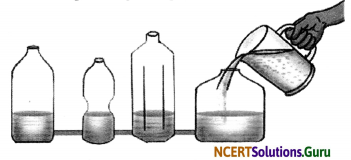
Hint:
Water fills in bottles according to air pressure. The bottle which has lesser air pressure will fill first. This is because air pressure opposes water flow. However, at the end, water level in all the bottles will be the same.
Activity 1
Objective: To demonstrate the electrostatic force.
Materials Required: A plastic straw, thread and a sheet of paper.
Procedure:
- Take a plastic straw and cut it into nearly two equal pieces.
- Suspend one of the pieces from the edge of a table with the help of a piece of thread.
- Now hold the other piece of straw in your hand and rub its free end with a sheet of paper.
- Bring the rubbed end of the straw near the suspended straw. Make sure that the two pieces do not touch each other.
- Now, rub the free end of the suspended piece of straw with a sheet of paper. Again. bring the piece of straw that was rubbed earlier with paper near the free end of the suspended straw.
Observation: In the first case, the suspended straw was attracted towards the straw in the hand. In the second case, there is repulsion between the straws.
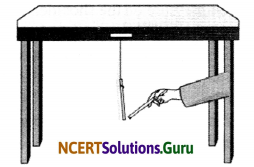
Conclusion: The force applied by a charged body on another charged or uncharged body is called electrostatic force. It is a non-contact force. Like charges repel while unlike charges attract each other.
c. Gravitational Force: Every object in the universe exerts a force on every other object. This force is called gravitational force. It is the gravitational force of various celestial bodies which keeps them in their position in the space. All things fall towards the earth because of gravitational force.
Pressure: Not only the magnitude of the force, but the area upon which it acts also affects the changes it may bring upon an object. The force acting upon a unit area is called pressure.
Pressure = \(\frac{\text { Force }}{\text { Area }}\)
The SI unit of pressure is Pascal (Pa) or N/m2. Hence, the pressure exerted by an object depends upon its surface area. If the surface area is small, the amount of pressure applied is large for the same force, and vice-versa. Following examples illustrate this effect:
- It is easier to push a nail into a wooden door through its pointed end than through its blunt end because the smaller area of the pointed end helps in creating more pressure and it becomes easier to insert the nail.
- Shoulder straps of school bags are wide. A larger area helps in reducing the pressure on the shoulder, and makes it less painful to carry the bag.
- Camel’s feet are wide and have a larger area. Due to this, a camel can easily walk on sand.
- Eskimos wear ski-like footwear. Wider area of the footwear reduces pressure and thus prevents the Eskimo’s feet from sinking in the ice.
Pressure Exerted by Liquids and Gases:
i. Liquids and gases exert pressure on walls of the container in which they are kept. Containers for gases and liquids are hence, usually cylindrical in shape to equally distribute the pressure on all portions of the wall.
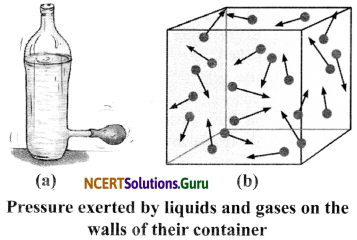
ii. The pressure exerted by a gas or a liquid on the bottom of its container, depends on the height of the column of gas or liquid in that container. Due to this, divers have to withstand a large pressure at the bottom of the sea.
iii. Liquids exert equal pressure at the same depth, while the pressure in liquids increases with depth.
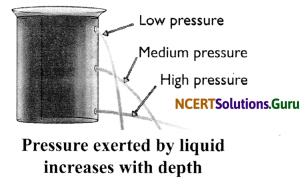
Activity 2
Objective: To show that liquids exert equal pressure at the same depth.
Materials Required: Empty plastic bottle, a borer and water.
Procedure:
- Take an empty plastic bottle and drill four holes all around near its bottom. Make sure that the holes are at the same height from the bottom.
- Now fill the bottle with water and observe.
Observation: The water streams coming out of the holes fall at the same distance.
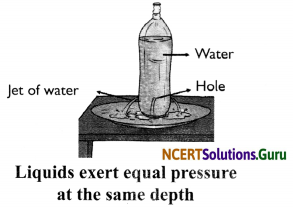
Conclusion: This shows that an equal pressure acts at the same depth in liquids.
Atmospheric Pressure: Our atmosphere is made up of different types of gases exert. Since gases exert pressure, the pressure exerted by air (present in atmosphere) is called atmosphere pressure. The weight of air in a column of the height of the atmosphere and area 10 cm x 10 cm is as large as 1000 kg. The reason we are not crushed under this weight is that the pressure inside our bodies is also equal to the atmospheric pressure and cancels the pressure from outside. A pressed rubber sucker on a plane surface does not come off because of atmospheric pressure.
![]()
Activity 3
Objective: To show the effect of pressure due to air.
Material Required: A good quality rubber sucker.
Procedure:
- Take a good quality rubber sucker. It looks like a small rubber cup.
- Press it hard on a smooth, plane surface. It sticks to the surface very hard.
- Now try to pull it off the surface and observe.
Observation: The sucker cannot be pulled off the surface, if there were no air at all between the sucker and the surface.

Conclusion: This shows the effect of pressure due to air. It shows that the atmospheric pressure is very large.
Class 8 Science Chapter 11 Force and Pressure Additional Important Questions and Answers
Very Short Answer Type Questions
Question 1.
What is force?
Answer:
A push or pull on an object is called force.
Question 2.
Define rest as a state of motion.
Answer:
When an object is not moving at all, i.e., has zero speed, it is said to be in the state of rest, e.g., a book lying on the table without any motion.
Question 3.
What is a contact force? Give examples.
Answer:
Contact force is a force which can produce its effect only by making a contact with the object, e.g., muscular force and frictional force.
Question 4.
What is a non-contact force?
Answer:
The non-contact force is a force which can produce its effect without making a contact with the object.
![]()
Question 5.
What is muscular force?
Answer:
It is the force applied by the muscles of humans or animals.
Question 6.
What is friction?
Answer:
When one surface is moving over another surface, a force comes into play and opposes their relative motion. This force is called friction or force of friction.
Question 7.
Which force stops the moving striker on a carrom-board?
Answer:
Frictional force.
Question 8.
What is electrostatic force?
Answer:
It is the force applied by a charged body on another charged or non-charged body.
Question 9.
Name any two types of non-contact forces.
Answer:
Magnetic force and gravitational force.
![]()
Question 10.
What is the relation between the direction of force of friction and the direction of motion?
Answer:
Direction of force of friction is always opposite to the direction of motion.
Question 11.
Which force enables the cars and buses to run on the roads?
Answer:
Cars and buses are able to run on roads because of the force of friction between the tyres and the road.
Question 12.
Does the force of gravitation exist between two objects on the earth?
Answer:
Yes, the force of gravitation exists between any two objects on the earth but it is very weak.
Question 13.
What is pressure?
Answer:
The force acting per unit area on an object is called pressure.
Question 14.
What is atmospheric pressure?
Answer:
The pressure exerted by atmospheric air is called atmospheric pressure.
Question 15.
Why don’t we feel atmospheric pressure?
Answer:
We don’t feel atmospheric pressure because pressure of air inside our body is equal to it and hence nullifies its effect.
Short Answer Type Questions
Question 1.
How do we feel force in our daily life?
Answer:
Many big or small actions make us feel the force. We have to push or pull many objects daily. A moving ball stops on its own. The ball changes the direction of its motion, when it is hit with a bat. Lifting, hitting, kicking, squeezing, etc., are all examples of force in daily life.
Question 2.
What happens when two people simultaneously exert equal forces in opposite directions on the same object?
Answer:
When two equal forces are exerted on an object from opposite sides in opposite direction, the forces get cancelled and there is no net force on the object. Such balanced forces cannot change the state of motion but the shape of the object can be changed.
![]()
Question 3.
What is the difference between contact and non-contact forces?
Answer:
| Contact force | Non-contact force |
| 1. This force needs to be in touch with the object in order to exert its effect. | 1. This force does not need to be in touch with the object to produce its effect. These forces can act at a distance. |
| 2. Examples: muscular force, friction, etc. | 2. Examples: magnetic force, electrostatic force, etc. |
Question 4.
Two tyres of a tractor are very wide and huge. Why?
Answer:
A wide tyre means a larger area. We know that pressure reduces when area increases. The wide tyres reduce the pressure exerted by the tractor. As a result, it becomes easier to drive a tractor on a muddy or a freshly ploughed surface.
Question 5.
It is easier to cut an apple with sharp end of knife rather than with its blunt end. Why?
Answer:
The sharp end of knife has much smaller area as compared to its blunt end. Smaller area provides more pressure for the same applied force. Hence, it becomes easier to cut an apple with sharp end of knife as compared to with its blunt end.
Question 6.
Why do some people suffer from nose bleeding at high altitudes?
Answer:
The atmospheric pressure is maximum on the surface of the earth. When we go to a higher altitude (say a high mountain), then the atmospheric pressure decreases. So, at high altitudes, the atmospheric pressure becomes much less than our blood pressure. Since our blood is at a higher pressure than the outside pressure, therefore, some of the blood vessels in our body may burst and nose bleeding can occur at high altitudes.
Question 7.
Why do astronauts wear special suits in space?
Answer:
Space suits help astronauts in several ways. Space is extremely cold and filled with dangerous radiations. It has no air to breathe and no air pressure. A space suit protects astronauts from these extreme temperatures. Spacesuits also supply astronauts with oxygen to breathe while they are in the vacuum of space. They contain water to drink during spacewalks. They protect astronauts from being injured from the impact of small bits of space dust.
Question 8.
If the area of your head is 15cm × 15cm, how much air (in weight) would you be carrying on your head?
Answer:
The weight of air column of the height of the atmosphere and area 15cm × 15cm is equal to the weight of an object of mass 225kg (2250N). We have air inside our body, so we are not crushed under this weight and pressure of air is equal at both the sides.
![]()
Question 9.
What are the factors on which the effect of force depends?
Answer:
There are two factors on which the effect of force depends:
- Magnitude: The strength of force is usually expressed by its magnitude.
- Direction of force: We also have to specify the direction of force in which it acts. If the direction or magnitude of force changes, its effect also changes.
Question 10.
What are the effects of force on a moving object?
Answer:
A force can have the following effects on a moving object:
- When the applied force is in the same direction as direction of motion, there is an increase in the speed of the object.
- When the applied force is in the direction opposite to the direction of motion, there is a decrease in the speed of object. The object may also come to rest in this case.
- When the applied force is at some acute or obtuse angle to the direction of motion, there is a change in the direction of motion of the object.
Question 11.
Arpita was wearing a high heel shoe on a beach party. Her friends told her to wear flat shoes as she will be tired soon with high heels and will not feel comfortable.
a. Why does one feel tired with high heel shoes on a beach?
b. Give the SI unit of pressure.
Answer:
a. The high heel shoe exerts lots of force while we walk on the sand. When we walk with high heel shoes in sand, it will sink into the sand and will exert more pressure. Hence, one feels tired.
b. The SI unit of pressure is Pascal.
Long Answer Type Questions
Question 1.
Explain some characteristics of force.
Answer:
Following are some characteristics of force:
- At least two objects need to interact for force to come into play. Mutual interaction between two objects results in a force between the two objects.
- When two forces are applied on an object in the same direction, there is an add-on effect of both the forces.
- When two forces are applied in opposite directions, the difference between the two forces gives the value of the net force.
- Force is expressed in terms of its magnitude and the direction in which it is working. If there is a change in direction or magnitude of the force, there is a change in the effect of force.
- Generally, more than one force may be acting on an object at any given time.
Question 2.
Forces are due to an interaction between the objects. Explain.
Answer:
Suppose a man is standing behind a stationary car. The car will not move due to his presence. Suppose the man now begins to push the car, that is, he applies a force on it. The car may begin to move in the direction of the applied force in this case. Hence, the man has to push the car to make it move.
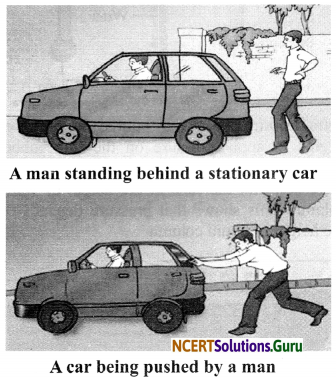
From this example, we can infer that at least two objects must interact for a force to come into play. Thus, an interaction of one object with another object results in a force between the two objects.
![]()
Question 3.
What are the characteristics of the pressure exerted by liquids and gases?
Answer:
Liquids and gases exert pressure as follows:
- A fluid exerts pressure on the walls of the container. Containers for gases and liquids are usually cylindrical in shape to equally distribute the pressure on all portions of the wall.
- Pressure at the bottom of the container depends on the height of the column of gas or liquid filled in it. Due to this, divers have to withstand a large pressure at the bottom of the sea.
- A fluid exerts equal pressure at the same depth. The pressure increases with increase in depth.
Question 4.
What are contact forces? Explain different types of contact forces.
Answer:
Contact forces are the forces which come into play when two objects are in direct contact with each other. Following forces are the contact forces:
a. Muscular Force: The force which is exerted due to the action of muscles is called muscular force. Actions like bending, running, moving, etc., are the examples of the muscular force. It is a contact force because it comes into play only when there is a contact of the muscles with the object.
b. Friction: It is a force which opposes the relative motion between two surfaces in contact. It is also a contact force because it is exerted when two surfaces come in contact with each other. Halting of a moving ball on its own is an example of force of friction which acts between the ball and surface in this case.
Question 5.
Explain the different types of non-contact forces.
Answer:
a. Magnetic Force: The force exerted by any magnetic object is called magnetic force. We know that like magnetic poles always repel each other, that is, they push each other away. Also, opposite magnetic poles always attract each other, that is, they pull each other towards themselves.

b. Electrostatic Force: The force exerted by a charged particle on another charged or uncharged particle is called electrostatic force. We know that like charges always repel or push each other away. Similarly, opposite charges always attract or pull each other towards themselves.
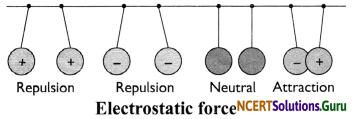
c. Gravitational Force: It is an attractive force that acts on all objects. It is the force by which the earth pulls the objects towards itself. Gravity is a property exhibited by every object present in the universe and not only the earth. Hence, all the planets, the moons and even the sun, all have a gravitational force of their own.
![]()
Question 6.
Explain with the help of an activity the pressure exerted by a liquid at the bottom of the container depends on the height of its column.
Answer:
Activity:
a. Take a plastic pipe open at both ends. To one end, tie a thin rubber sheet.
b. Ask one of your friends to pour some water in the pipe. The rubber sheet bulges out when the water column in the pipe rises.
c. Note the height of the w’ater column in the pipe.
d. Pour some more water. Again observe the bulge in the rubber sheet and the height of the water column in the pipe.
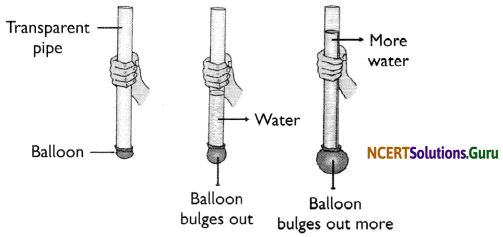
Conclusion: The water poured in the pipe begins to apply pressure on the thin rubber sheet, due to which it begins to bulge. The bulge increases with increase in the height of water column. This shows that pressure depends on the height of liquid column.
Picture-Based Questions
Question 1.
Observe the following figure and answer the questions.
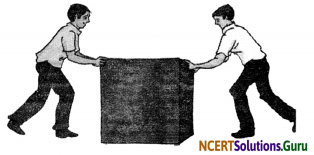
a. What are these two boys in the figure doing?
b. What is the direction of forces applied by these two men?
c. What will be the net force in this case?
Answer:
a. These two boys are applying the force on a block.
b. Both of them are applying the force in opposite directions.
c. The difference of two forces will be the net force in this case.
![]()
Question 2.
Observe the following figure and answer the questions.

a. What is the man doing?
b. Why do such men place a round piece of cloth on their head?
Answer:
a. This porter is carrying heavy loads on his head.
b. They use the round piece of doth on their head because it increases the surface area on which the force will act and this reduces pressure on their head.
Question 3.
Observe the following figure and answer the questions.
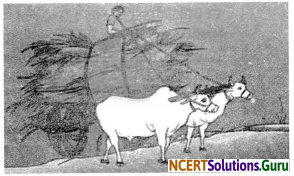
a. What are the bullocks doing?
b. What type of force is applied by the bullocks?
c. Is it a contact or a non-contact force?
Answer:
a. Bullocks are drawing the heavy loads.
b. Muscular force is applied by the bullocks.
c. It is a contact force.